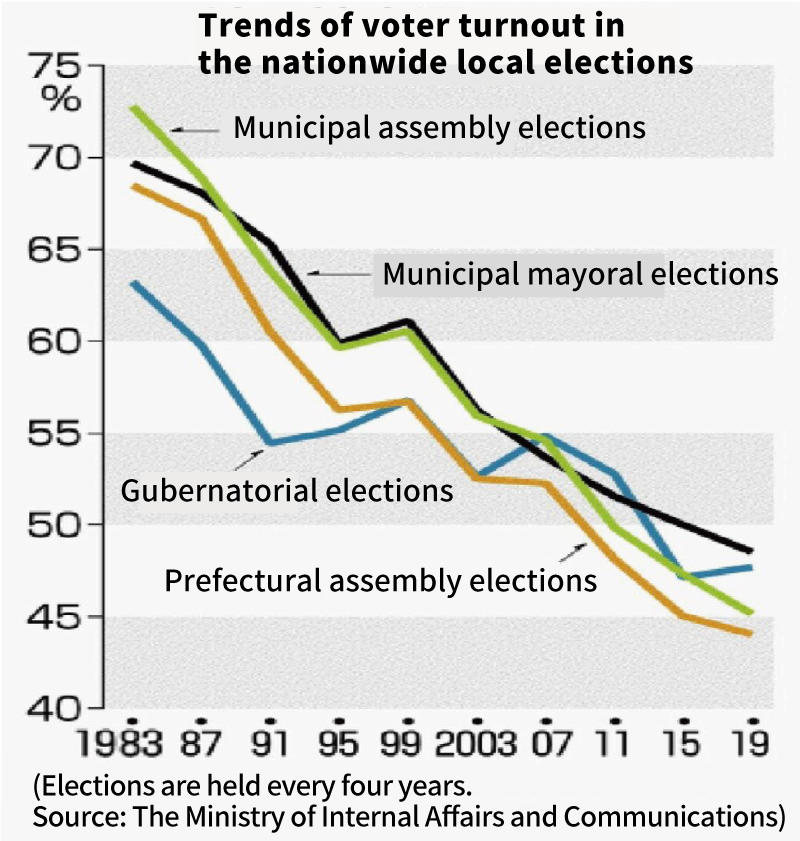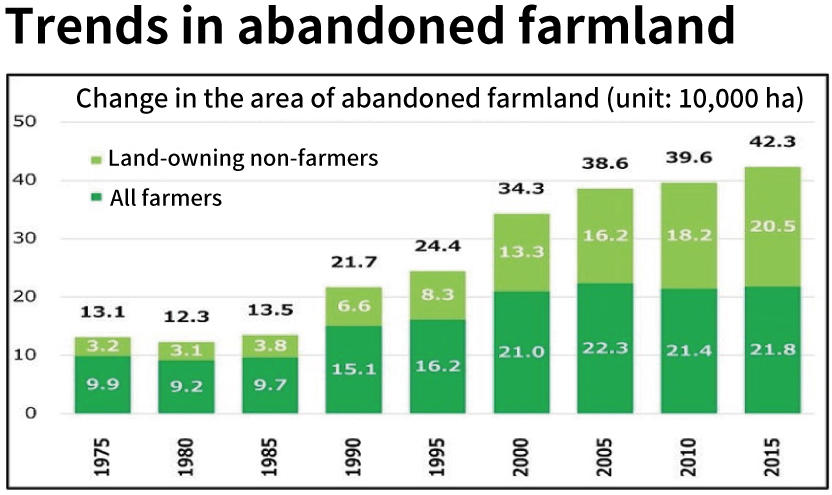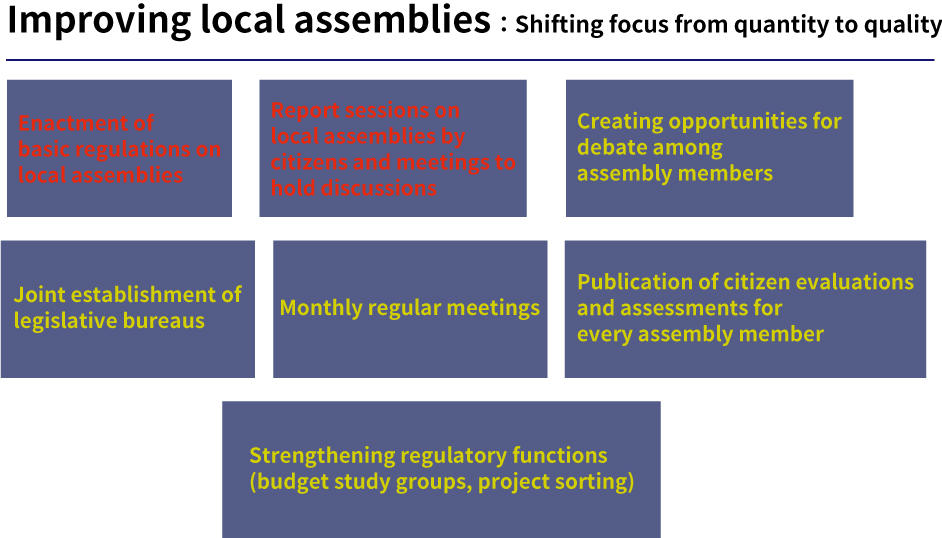Issues and Challenges Surrounding the 2023 Local Elections
Nobuo Sasaki/Professor Emeritus of Chuo University and scholar of public administration
Fields of specialization: Public administration and local government autonomy
In the past three years, the COVID-19 pandemic has been greatly damaging to local communities. Local governments, which are responsible for two-thirds of the government administration of Japan, are expected to actively respond to problems occurring in their respective regions. The challenge is to figure out how to allocate their limited financial resources to solve the ever-growing list of problems. The capability of local governments to sustainably manage their administrative responsibilities has never before been tested to this extent. This is where political institutions including legislative bodies and executive offices come in.
◆ What are nationwide local elections?
In April 2023 amid such circumstances, we are about to hold the 20th nationwide local elections since the end of World War II. Prefectural and ordinance-designated cities will hold elections for governors and local assembly members on April 9, and municipalities will follow with mayoral and local assembly elections on April 23. With no national elections scheduled for this year, political parties are staking their fates on these local elections. As they are called "unified" local elections, the elections for mayors and local assembly members of 47 prefectures, 1,718 municipalities, and 23 special wards are meant to be held simultaneously. However, although the first nationwide local elections held in 1947 were 100% unified, less than 30% are held in a unified manner these days. This is because in the 80 years since the end of the war, two major municipal mergers have occurred: once during the Showa period, and again during the Heisei period, as well as the resignation of mayors in the middle of their terms have led the timing of elections being dispersed.
This year's elections comprise 234 mayoral elections and 747 local assembly elections, and only 27.54% of these will be unified. An approximate breakdown of those running for election is as follows: 20% of governors and mayors of ordinance-designated cities; 10% of municipal mayors; 50% of special ward mayors; 40% of general local assembly members; 80% of prefectural and ordinance-designated city assembly members; and 90% of special ward assembly members are running for re-election. Until 10 years ago, the highlight of the nationwide local elections was the Tokyo gubernatorial election. However, Tokyo's timing of is no longer in sync with other elections, and although the gubernatorial elections in Osaka, Nara, and Hokkaido are attracting attention this year, there is no captivating narrative surrounding a "capital city in disarray." This has led to the public not being particularly excited about these elections.
In this regard, the impact of these elections may be limited despite all the noise made by political parties and the media. However, for local governments, these elections will determine the course of the next four years, and will therefore have a wide impact. For the Kishida administration, the evaluation of local politics is directly linked to the outcome of national politics. For this reason, these elections warrant careful consideration.
Another point is that although elections are an important opportunity for citizens to participate in politics, the turnout of eligible voters has continued to decline with each passing election, falling below 50% in every election (Figure: from the Ministry of Internal Affairs and Communications). How should we view a situation in which the majority of eligible voters do not go to the polls?

How can we improve this situation? Four years ago, the government lowered the voting age to 18, and revised the system to allow 2.5 million young voters to participate in local elections, but we have yet to see the effects of these changes. Whether or not there will be a move to reverse these changes will be the focus of attention as a political move that reflects the will of the people. Also, a substantial number of local assemblies has no women serving as members. In addition, the proportion of women in local assemblies is only at around 10%, which is said to be the worst in the world. We must consider whether it is possible to change this exclusionary mindset, in which politics is considered to be the domain of men, making it difficult for women to join local assemblies. Furthermore, is it possible to change the current situation in which over 30% of local elections are uncontested, not only in small, low-population municipalities, but also in prefectural assembly elections, leading to a result where citizens are represented for four years without such representation being challenged by elections? If this situation continues, our system of managing elections will need to undergo some changes.
◆ What are the policy issues and challenges?
The main challenge is knowing what issues to focus on. Today, regardless of whether it is about national or local politics, Japan faces a variety of nationwide problems and issues related to population decline, as well as a wide range of societal problems such as medical care, nursing care, pensions, welfare, childcare, abandoned houses and farmlands, labor shortages, aging infrastructure, the declining vitality of local communities, insufficient tax revenue, and the collapse of villages.
In particular, the negative impacts of the COVID-19 pandemic in the past three years have been severe in communities across the country, leading to the inevitable stagnation of local economies, and a significant decline in tax revenues. Local governments face the dilemma of an ever-accumulating list of issues that need to be addressed and insufficient financial resources. For local governments, the challenge of making the most of limited management resources will be a test of their governing capabilities.
Over the past 10 years, since the start of the second Abe administration to the present, the government has been waving the banner of regional revitalization, but moves on the ground have been lacking. Due to the tight fiscal conditions experienced by regions across the country, there has been a noticeable tendency to rely on subsidies and grants by the national government, without any signs of internal efforts to leverage regional strengths to craft policies. Without these achievements, what is the point of regional revitalization? We should be having substantive debates about local governments facing their citizens rather than looking only to the national government for support, in order to solve local issues in a self-reliant, self-sufficient manner. This is the common thread that ties together the issues we face in gubernatorial, mayoral, and local assembly elections.
Looking at these issues individually, we find ourselves facing many challenges. For example, the number of children continues to decrease across the country, and 500 elementary and junior high schools are closed every year. What should be done with these vacant facilities? In urban areas, the issues of children on waiting lists and the conversion of facilities to childcare facilities are points of contention, while in rural areas, the conversion of facilities to nursing care facilities is another point of contention. The issue of abandoned houses is also a serious problem. The nationwide vacant housing rate is increasing year by year, and nearly 15% of houses are already vacant. As the population moves to urban areas, there are even entire villages where every home has become vacant. In urban areas, there are many abandoned houses where it is not known who has inherited them, and clearing abandoned houses has become an urgent priority for crime prevention and beautification. However, even if we say that abandoned houses are a social problem on the grounds of absolute ownership, the authorities cannot intervene so easily. The tax system should be revised to give preferential treatment to abandoned houses. Also, why not take advantage of these abandoned houses by creating vacant house banks and turn to measures to bring the population back, such as satellite offices and second housing? This requires wide-ranging wisdom.
The amount of abandoned farmlands is steadily increasing (Figure: from the Ministry of Agriculture, Forestry and Fisheries). As with the vacant house problem, can't we view the issue from fresh perspectives and come up with ways to utilize this land? Furthermore, along with the human issues of the declining birthrate and aging population, aging infrastructure is also a serious problem. From roads to bridges, public facilities, schools, and water and sewage systems, all of the infrastructure for daily life that was built 50 years ago during Japan's period of rapid economic growth has now exceeded its 50-year service life and is rapidly deteriorating. It will cost nine or ten trillion yen to renew this infrastructure. Of course, since the population is rapidly declining, we must also reconsider whether this infrastructure is even essential for these regions. In addition to this, the problem of local railroads and bus routes closing in rural and farming areas is also becoming more serious.

◆ The state of local assemblies as another point of contention
The shortage of aspiring local assembly members is also a serious problem. In addition, we are seeing the emergence of public discourse that questions the very foundation of parliamentary democracy, including the discussion of whether local assemblies even have any value. What is important is to reaffirm the role of local assemblies. Japan's system of local government, which is based on a two-tier representation system, consists of an assembly as the voting body and a mayor or governor as the executive body, and this chief cannot act without a decision from the assembly. There is a general understanding in the world that the executive chief dominates and leads political action, but this is not the case. It is supposed to be the case that local governments run under the leadership of the legislature. The problem is that the lack of power in local assemblies gives the impression that executive power is superior. Therefore, it is extremely important for local assemblies to fulfil not only the functions of deliberation, decision-making, and monitoring of executive actions, but also play a wide range of roles such as garnering the will of the people and proposing policies. It is crucial that we develop a system that is suitable for these purposes. For example, we could create a system wherein municipalities in a wide area can jointly create a system to strengthen their legislative and review functions, such as by creating a multi-municipality legislative bureau. These are the kinds of initiatives for which we should be allocating funds for government activities. Why don't local assemblies actively propose and promote the policies necessary for local communities and work towards consensus-building? This is also a major point of contention in the nationwide local elections.
Reforming local assemblies is an urgent matter (Figure: from the author). What is more important than the salaries or the number of local assembly members is improving the quality of local assemblies and their members. If the local assemblies in regions across Japan are revitalized, those regions will see positive change. If these regions change for the better, so will Japan as a whole. This will ultimately be for the benefit of the health of Japan.

I look forward to debates on these topics in the nationwide elections that will serve as catalysts to reforming local assemblies, and to the dynamism of subsequent reforms. In this way, the nationwide local elections held this year are an opportunity to ask fundamental questions about the internal problems of Japan and the state of local regions.
Nobuo Sasaki/Professor Emeritus of Chuo University and scholar of public administration
Fields of specialization: Public administration and local government autonomyNobuo Sasaki was born in Iwate Prefecture in 1948. He graduated from Waseda University, and completed the political science course at Waseda University Graduate School. He obtained a Ph.D. in law from Keio University. After working at the Tokyo Metropolitan Government for 16 years, he became a professor at Seigakuin University in 1989. He then became a professor at Chuo University from 1994 to 2018. In April 2018, he became a professor emeritus at Chuo University. He specializes in public administration and local government autonomy. During this time, he also served as a lecturer at Keio University, Nihon University, and Meiji University Graduate School, a member of the Science Council of Japan (political science), a member of the Local Government System Research Council (the 31st session), and a special advisor to the Osaka municipal and prefectural governments.
Publications include Gendai Toshi Gyoseigaku Kenkyu ("Contemporary Urban Administration Studies"; Keiso Shobo), Imakoso Datsu Tokyo ("Now is the Time to Leave Tokyo"), Arata na Kuni no Katachi ("The New Shape of Japan"), Chihou Giin no Gyakushu ("The Revenge of Local Assembly Members"), Doshusei ("The Administrative Reform Proposal"), Jichitai wa Kawareru ka ("Can Local Governments Change?"), Tokyo Tosei ("Tokyo Metropolitan Government"), and Tocho—Mo Hitotsu Seifu ("The Tokyo Government Office—Another Government").









